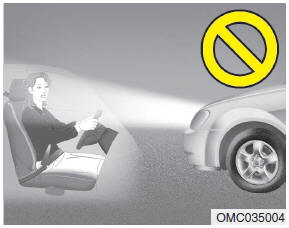 Hyundai Veloster: Driving at night
Hyundai Veloster 2011-2017 Owner's Manual / Driving your vehicle / Special driving conditions / Driving at night
Hyundai Veloster: Driving at night
Hyundai Veloster 2011-2017 Owner's Manual / Driving your vehicle / Special driving conditions / Driving at night

Because night driving presents more hazards than driving in the daylight, here are some important tips to remember:
- Slow down and keep more distance between you and other vehicles, as it may be more difficult to see at night, especially in areas where there may not be any street lights.
- Adjust your mirrors to reduce the glare from other driver's headlights.
- Keep your headlights clean and properly aimed on vehicles not equipped with the automatic headlight aiming feature. Dirty or improperly aimed headlights will make it much more difficult to see at night.
- Avoid staring directly at the headlights of oncoming vehicles. You could be temporarily blinded, and it will take several seconds for your eyes to readjust to the darkness.
 Smooth cornering
Smooth cornering
Avoid braking or gear changing in corners, especially when roads are wet. Ideally,
corners should always be taken under gentle acceleration. If you follow these suggestions,
tire wear will be he ...
 Driving in the rain
Driving in the rain
Rain and wet roads can make driving dangerous, especially if you’re not prepared
for the slick pavement. Here are a few things to consider when driving in the rain:
A heavy rainfall will make ...
See also:
Front Wheel Speed Sensor. Repair procedures
Removal
1.
Remove the front wheel and tire.
Tightening torque:
88.3 ~ 107.9 N.m (9.0 ~ 11.0 kgf.m, 65.1 ~ 79.6 lb-ft)
...
Sunglass holder
To open the sunglass holder, press the cover and the holder will slowly open.
Place your sunglasses in the compartment door with the lenses facing out. Push to
close.
WARNING
• Do not kee ...
Alignment. Repair procedures
Front Wheel Alignment
• When using a commercially available computerized wheel alignment
equipment to inspect the front whee ...
Categories
- Hyundai Veloster Manuals Home
- Hyundai Veloster 2010-2017 Owner's Manual
- Hyundai Veloster 2010-2017 Service Manual
